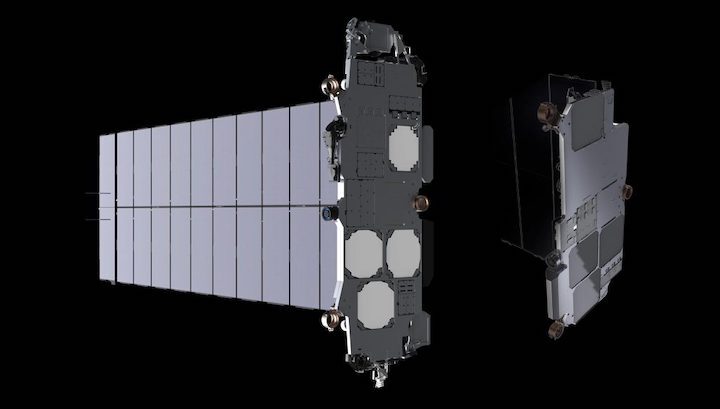30.05.2022

SpaceX CEO Elon Musk has revealed the first technical details about the company’s next-generation Starlink ‘Gen2’ satellite design, confirming that it will far outmatch the current generation of satellites by almost every measure.
Speaking in an onsite interview and Starbase tour with YouTuber Tim Dodd (The Everyday Astronaut), Musk – largely unprovoked – revealed that SpaceX has already built at least one functional Starlink Gen2/V2.0 satellite prototype and shipped it to the South Texas Starship factory, where it is currently being stored. More importantly, Musk also provided the first direct specifications for the next-generation spacecraft, stating that each Starlink V2.0 satellite will weigh about 1.25 tons (~2750 lb), measure about seven meters (~23 ft) long, and be almost an order of magnitude more capable than the “Starlink 1” satellites they’ll ultimately supersede.
Almost ten months after SpaceX first revealed its updated plans for a next-generation, 30,000-satellite constellation, those details have confirmed a few key points of speculation about the future of Starlink.
Back in August 2021, I surmised that just like it has with Falcon 9, SpaceX would again try to optimize its new Starlink V2.0 satellite design to take maximum advantage of Starship’s launch performance. In an updated Starlink Gen2 filing, the company conveniently revealed that a version of the constellation optimized for Starship would be structured such that the rocket could launch an entire orbital plane (one ring of satellites spaced evenly around the Earth) in one go. In that constellation variant, all but ~500 (1.5%) of almost 30,000 spacecraft would be stationed in planes of 110 or 120 satellites, meaning that it was safe to assume that SpaceX meant that every Starship would nominally carry 110-120 satellites. Using Musk’s latest optimistic Starship performance estimate of 150 tons to low Earth orbit (LEO), that all but guaranteed that a Starship-optimized Starlink V2.0 satellite would weigh up to 1250 kilograms.
Musk has now explicitly confirmed that each Starlink V2.0 satellite will weigh… “about one and a quarter tons” or 1250 kilograms. Starlink V1.0 and V1.5 satellites weigh around 260 and 310 kilograms, respectively, meaning that Starlink V2.0 satellites will be about a bit more than four times heavier than V1.5 and a bit less than five times heavier than V1.0.
Musk also revealed that V2.0 satellites will be “almost an order of magnitude more capable than Starlink 1.” He refused to call that capability bandwidth or throughput, the traditional method of describing a communication satellite’s total performance, but Starlink V1.0 satellites are believed to have a total bandwidth of 18 gigabits per second (18 Gbps). As of today, it’s unknown if Starlink V1.5 – a significant upgrade – also added more bandwidth, nor if Musk was referring to that latest Starlink V1.x iteration. But even if he was comparing V2.0 with the earliest V1.0 satellites, it’s possible that each Starlink V2.0 satellite could add around 140-160 Gbps to the 30,000-satellite constellation.

Ultimately, specific numbers aren’t needed to emphasize the importance of the details Musk provided. If true, they mean that Starlink V2.0 will pack roughly twice as much usable bandwidth into a given unit of satellite mass compared to V1.x. Combined with the fact that Starship could offer ~10 times as much performance to LEO as Falcon 9, a single Starship launch could theoretically expand total network capacity roughly twenty times more than one Falcon 9 launch. For example, each Falcon 9 launch of 60 260-kilogram Starlink V1.0 satellites added about 1080 Gbps of instantaneous bandwidth to the constellation. A Starship launch of 120 1250-kilogram Starlink V2.0 satellites could add around 19,000 Gbps (19 terabits per second).
Even despite those massive advantages, SpaceX’s Starlink Gen2 ambitions still leave it no slack whatsoever. If the FCC approves its license request, SpaceX would need to launch half of the constellation within six years – equivalent to around 130 Starship launches or 22 Starship launches per year. In comparison, Falcon 9 – a rocket that’s ten times smaller, less reusable, and has been flying since 2010 – did not achieve 22 launches in one year until 2020. For Starship to have any hope of achieving the cadence Starlink Gen2 requires, SpaceX would have to ramp up launches of the largest rocket ever built at a truly miraculous pace and suffer very few failures or setbacks along the way.
As immense as the challenge may be, the potential rewards are just as high. A constellation of 30,000 Starlink V2.0 satellites – if spaced evenly around the Earth – could have a total bandwidth of ~1250 terabits per second (Tbps) available over land (excluding Antarctica) at any given second. Even if half of that bandwidth is needed for backhaul and routing, the total installed bandwidth of global internet infrastructure was estimated to be 600 Tbps in 2020. Starlink will always be bottlenecked by the number of satellites that can be simultaneously available over any single point on Earth, so the constellation will never be able to match a ground network 1:1 with the same installed capacity, but it’s safe to assume that Starlink Gen2 could serve tens or even hundreds of millions of users located anywhere on Earth if SpaceX is able to build it.
Quelle: TESLARATI
